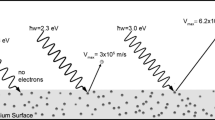Abstract.
The photon emission rate of a thermally equilibrated system is determined by the imaginary part of the in-medium retarded correlator of the electromagnetic current transverse to the spatial momentum of the photon. In a Lorentz-covariant theory, this correlator can be parametrized by a scalar function \(\mathcal{G}_R(u\cdot \mathcal{K},\mathcal{K}^{2})\), where u is the fluid four-velocity and \(\mathcal{K}\) corresponds to the momentum of the photon. We propose to compute the analytic continuation of \( \mathcal{G}_R(u\cdot \mathcal{K},\mathcal{K}^{2})\) at fixed, vanishing virtuality \( \mathcal{K}^{2}\), to imaginary values of the first argument, \( u\cdot \mathcal{K} = i\omega_{n}\). At these kinematics, the retarded correlator is equal to the Euclidean correlator \( G_{E}(\omega_{n},k=i\omega_{n})\), whose first argument is the Matsubara frequency and the second is the spatial momentum. The Euclidean correlator, which is directly accessible in lattice QCD simulations, must be given an imaginary spatial momentum in order to realize the photon on-shell condition. Via a once-subtracted dispersion relation that we derive in a standard way at fixed \( \mathcal{K}^{2}=0\), the Euclidean correlator with imaginary spatial momentum is related to the photon emission rate. The relation allows for a more direct probing of the real-photon emission rate of the quark-gluon plasma in lattice QCD than the dispersion relations which have been used so far, the latter being at fixed spatial photon momentum k and thus involving all possible virtualities of the photon.
Article PDF
Similar content being viewed by others
Avoid common mistakes on your manuscript.
References
P. Braun-Munzinger, V. Koch, T. Schaefer, J. Stachel, Phys. Rep. 621, 76 (2016) arXiv:1510.0044
S. Campbell, Nucl. Phys. A 967, 177 (2017) arXiv:1704.0630
T. Asaka, M. Laine, M. Shaposhnikov, JHEP 06, 053 (2006) arXiv:hep-ph/0605209
R. Adhikari, A white paper on kev sterile neutrino dark matter, arXiv:1602.0481
P.B. Arnold, G.D. Moore, L.G. Yaffe, JHEP 12, 009 (2001) arXiv:hep-ph/0111107
J. Ghiglieri, J. Hong, A. Kurkela, E. Lu, G.D. Moore et al., JHEP 05, 010 (2013) arXiv:1302.5970
D.T. Son, A.O. Starinets, JHEP 09, 042 (2002) arXiv:hep-th/0205051
J. Casalderrey-Solana, H. Liu, D. Mateos, K. Rajagopal, U.A. Wiedemann, Gauge/string duality, hot QCD and heavy ion collisions, arXiv:1101.0618
P.M. Hohler, R. Rapp, Phys. Lett. B 731, 103 (2014) arXiv:1311.2921
R. Rapp, H. van Hees, Eur. Phys. J. A 52, 257 (2016) arXiv:1608.0527
Y. Hidaka, S. Lin, R.D. Pisarski, D. Satow, JHEP 10, 005 (2015) arXiv:1504.0177
C. Gale, Y. Hidaka, S. Jeon, S. Lin, J.-F. Paquet, R.D. Pisarski, D. Satow, V.V. Skokov, G. Vujanovic, Phys. Rev. Lett. 114, 072301 (2015) arXiv:1409.4778
J.-F. Paquet, C. Shen, G.S. Denicol, M. Luzum, B. Schenke, S. Jeon, C. Gale, Phys. Rev. C 93, 044906 (2016) arXiv:1509.0673
R.-A. Tripolt, C. Jung, N. Tanji, L. von Smekal, J. Wambach, In-medium spectral functions and dilepton rates with the Functional Renormalization Group, in 27th International Conference on Ultrarelativistic Nucleus-Nucleus Collisions (Quark Matter 2018) Venice, Italy, May 14–19, 2018 (Elsevier, 2018) arXiv:1807.0495
J. Ghiglieri, O. Kaczmarek, M. Laine, F. Meyer, Phys. Rev. D 94, 016005 (2016) arXiv:1604.0754
B.B. Brandt, A. Francis, B. Jäger, H.B. Meyer, Phys. Rev. D 93, 054510 (2016) arXiv:1512.0724
G. Aarts, C. Allton, A. Amato, P. Giudice, S. Hands, J.-I. Skullerud, JHEP 02, 186 (2015) arXiv:1412.6411
B. Brandt, A. Francis, M. Laine, H. Meyer, JHEP 05, 117 (2014) arXiv:1404.2404
L.D. McLerran, T. Toimela, Phys. Rev. D 31, 545 (1985)
S. Caron-Huot, Phys. Rev. D 79, 065039 (2009) arXiv:0811.1603
M. Panero, K. Rummukainen, A. Schaefer, Phys. Rev. Lett. 112, 162001 (2014) arXiv:1307.5850
X.-d. Ji, C.-w. Jung, Phys. Rev. Lett. 86, 208 (2001) arXiv:hep-lat/0101014
A.J. Chambers, R. Horsley, Y. Nakamura, H. Perlt, P.E.L. Rakow, G. Schierholz, A. Schiller, K. Somfleth, R.D. Young, J.M. Zanotti, Phys. Rev. Lett. 118, 242001 (2017) arXiv:1703.0115
J.J. Dudek, R.G. Edwards, Phys. Rev. Lett. 97, 172001 (2006) arXiv:hep-ph/0607140
X. Feng, S. Aoki, H. Fukaya, S. Hashimoto, T. Kaneko et al., Phys. Rev. Lett. 109, 182001 (2012) arXiv:1206.1375
A. Gérardin, H.B. Meyer, A. Nyffeler, Phys. Rev. D 94, 074507 (2016) arXiv:1607.0817
B.B. Brandt, A. Francis, T. Harris, H.B. Meyer, A. Steinberg, EPJ Web of Conferences 175, 07044 (2018) arXiv:1710.0705
H.B. Meyer, Eur. Phys. J. A 47, 86 (2011) arXiv:1104.3708
S. Weinberg, The Quantum theory of fields. Vol. 1: Foundations (Cambridge University Press, 1995)
J. Hong, D. Teaney, Phys. Rev. C 82, 044908 (2010) arXiv:1003.0699
G. Cuniberti, E. De Micheli, G.A. Viano, Commun. Math. Phys. 216, 59 (2001)
F. Ferrari, Nucl. Phys. B 909, 880 (2016) arXiv:1602.0735
P. Aurenche, F. Gelis, G. Moore, H. Zaraket, JHEP 12, 006 (2002) arXiv:hep-ph/0211036
M. Lüscher, S. Sint, R. Sommer, P. Weisz, U. Wolff, Nucl. Phys. B 491, 323 (1997) arXiv:hep-lat/9609035
J.I. Kapusta, C. Gale, Finite-Temperature Field Theory: Principles and Applications (Cambridge University Press, 2006) p. 428
P.K. Kovtun, A.O. Starinets, Phys. Rev. D 72, 086009 (2005) arXiv:hep-th/0506184
S. Caron-Huot, P. Kovtun, G.D. Moore, A. Starinets, L.G. Yaffe, JHEP 12, 015 (2006) arXiv:hep-th/0607237
Author information
Authors and Affiliations
Corresponding author
Additional information
Communicated by D. Blaschke
Rights and permissions
Open Access This article is distributed under the terms of the Creative Commons Attribution 4.0 License (https://doi.org/creativecommons.org/licenses/by/4.0), which permits unrestricted use, distribution, and reproduction in any medium, provided the original work is properly cited.
About this article
Cite this article
Meyer, H.B. Euclidean correlators at imaginary spatial momentum and their relation to the thermal photon emission rate. Eur. Phys. J. A 54, 192 (2018). https://doi.org/10.1140/epja/i2018-12633-0
Received:
Accepted:
Published:
DOI: https://doi.org/10.1140/epja/i2018-12633-0




